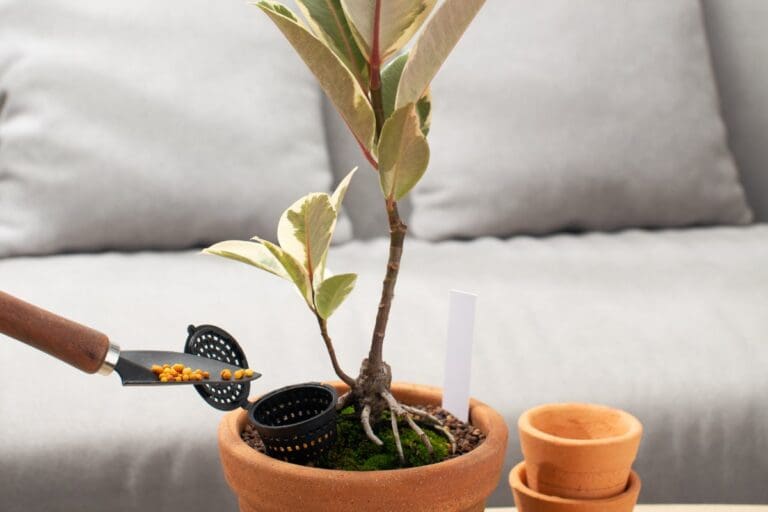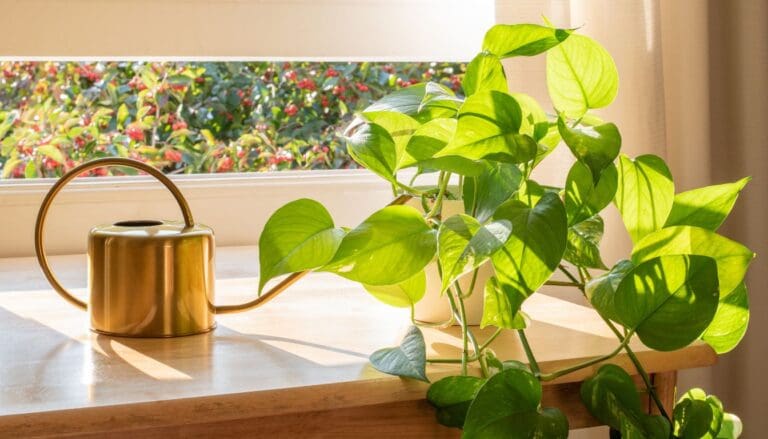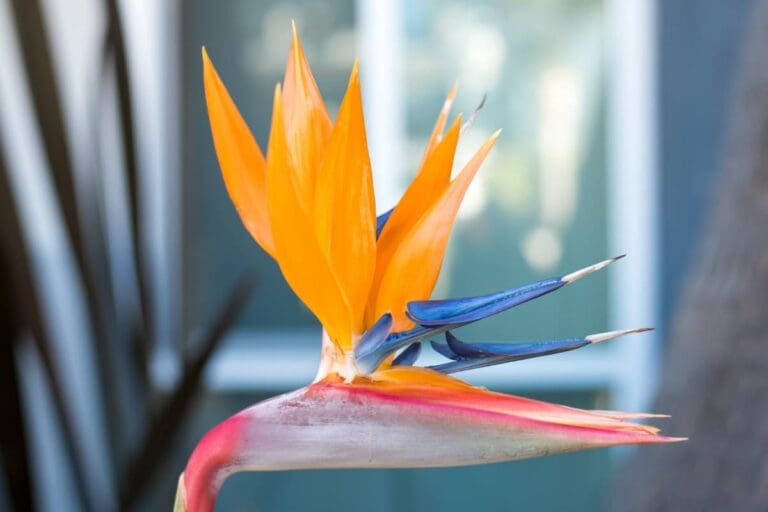Do Fiddle Leaf Figs Like To Be Root Bound? (+ How To Fix It)
Fiddle leaf figs (Ficus lyrata) have been popular in the houseplants community because of their beautiful leaves that make your living space aesthetically pleasing. But do fiddle leaf figs like to be root bound? Let’s find out.
Fiddle leaf figs don’t like to be root bound. Rootbound is a condition when the plant roots have displaced all the soil, and it doesn’t have enough space to grow. As a result, the plant doesn’t get enough water and nutrients to survive and remain healthy.
Fiddle leaf figs love to remain snug in the pots that make them root-bound. Their roots grow fast, and when you notice that the roots are coming out of the drainage holes, you know you have a root-bound plant.
The roots coming out of drainage holes will block water inside the pot, eventually leading to root rot. This is when you should repot your fiddle leaf fig.
It would be best if you repotted your fiddle leaf fig every 2-3 years. These plants grow fast and can soon outgrow the pot, and you will notice the roots coming out of the drainage holes.
If you don’t repot the fiddle leaf fig on time, the plant’s growth will slow down, and it will start developing other problems as well. Droopy leaves and stunted growth are common signs of a root-bound plant.
Read this article till the end to understand the signs that your fiddle leaf fig has become root-bound and find out how you can save a root-bound fiddle leaf fig.

Please note: Simplify Plants is reader-supported. Some links in the post are affiliate links and I get a commission from purchases made through links in the post.
Do fiddle leaf fig trees like to be root bound?
Yes, fiddle leaf figs love to be root bound. Fiddle leaf figs grow very fast, and in that process, the plant often becomes root bound.
Fiddle leaf figs are native to Western Africa’s rainforests, and in their natural habitat, they can grow without restrictions.
Their roots grow long and deep and can suck in the water and nutrients required for the plant’s growth.
When these plants grow in pots, they have restricted space, and therefore the roots cannot grow freely.
If you keep the plant in the same pot for an extended period, the roots will not have the space to grow further and will lose the capacity to absorb nutrients from the soil, which will make it weak.
So it would be best if you repotted your fiddle leaf fig in a larger pot, so it always has space and energy to grow and expand.
How to tell if fiddle leaf fig is root bound?

Here are some of the signs that you might notice if your fiddle leaf fig is root-bound:
- The soil dries out quickly
- The plant keeps falling on the sides
- Brown tips on the leaves
- Roots coming out of the drainage holes
- Pot starts cracking and expanding
- Spiraling roots at the bottom
- Stunted growth
- Droopy leaves
- Slow growth
If you notice one or more signs, it means you have a root-bound fiddle leaf fig, and you will have to do something about it.
If you don’t do anything about it, your plant will start wilting. One way to treat this is to repot your plant.
Using the wrong-sized pot for your plant causes it to become root-bound.
Maybe you are keeping the plant in a small pot or outgrown the current pot.
When the roots grow in number and are longer, they fill up the pot, and there is no space for further growth. As the roots don’t get the room to grow, growth also slows down in other parts of the plant.
How do you fix a root-bound fiddle leaf fig?
If you have a root-bound fiddle leaf fig, you need to repot it to let it grow more freely.
Repot my fiddle leaf fig
If you have a root-bound fiddle leaf fig, the easiest way to fix it is to repot the fiddle leaf fig.
You would need to repot the fiddle leaf fig in a larger pot as it had outgrown the previous one.
A larger pot allows the roots to grow freely while fresh soil adds nutrients to the plant.
It would be best not to choose a container that is too big as that would retain water and not be appropriate for the plant. An overlarge pot gives rise to overwatering problems and root rot.
While choosing the pot, you should choose a pot that is one size bigger than the current one, which means it should be 2-3 inches bigger in size.
Once you have selected the new pot, you can transplant the fiddle leaf fig by following these steps.
- Prepare a new soil mix.
Start by preparing a new soil mix for the plant. You can take a separate container and mix all the ingredients to make the perfect soil for your fiddle leaf fig.
- Take the plant out of the pot.
Be very careful while taking the plant out of the pot as you would not want to cause any damage to the plant.
Hold the stem of the plant and lift it out of the pot slowly. Taking the plant out of the pot should not be a problem, but if it gets tricky, you can press the pot a little to get the plant out of it.
- Remove the soil from the roots.
Whenever you want to repot a plant, you should remove most of the old soil from the roots without causing any damage.
You can wash the soil from the roots by placing it under a tap and running warm water over it gently.
Or, place the plant in a bucket of water and let the soil get washed away from the roots.
- Remove damaged parts
If there are any damaged roots or roots that have grown too long, you should consider cutting those off.
That will stimulate new growth in the plant.
- Add soil to the new pot and place the plant in the pot.
Fill up the planter with 1/3rd of the new soil. Place the fiddle leaf fig back in the pot. Cover the sides with fresh soil.
You can ask someone to hold the plant upright while you fill the sides of the pot with fresh soil. Gently pat it around the roots to provide support to the plant.
- Water after transplanting
Finally, water the plant well. This will also help the plant to recover from the stress of repotting.
When to repot fiddle leaf fig?

Consider repotting your fiddle leaf fig every 2-3 years irrespective of whether it is root-bound or not.
Repotting the plant allows the nutrients to get replenished in the soil that boosts the plant’s growth.
In case your fiddle leaf fig is root-bound, you should immediately repot it.
Fiddle leaf figs love consistency, so never repot during the winter as low temperature and transplantation will cause shock and stress.
The best time to repot fiddle leaf figs is when they are active. Repotting during the summer or spring months would be best as the plants are most active during that time.
Best soil and container for repotting fiddle leaf figs

Using the correct sized pot plays a crucial role in having a healthy fiddle leaf fig.
If you have a root-bound fiddle leaf fig, you should use a 2-3 inches bigger pot than the current one.
It would be best if you never used a too-large pot as the plant will use all its energy in growing the roots rather than the foliage. The plant will focus on holding the soil first.
The most important thing is that the pot should have proper drainage holes to let the excess water drain away.
If the excess water does not drain out, the fiddle leaf fig will sit on the water and be subject to root rot.
When it comes to soil, you should look for a soil mix that allows excess water to drain out from the bottom of the pot.
Fiddle leaf figs don’t like sitting in water so getting well-draining soil is a must.
The soil should contain air pockets even when it is fully saturated.
After you have watered your fiddle leaf fig, excess water should drain out of the bottom of the pot.
Keeping your fiddle leaf fig potted in the same soil for an extended period can increase the soil’s acidity, which is harmful to the plant. Fiddle leaf figs like slightly acidic soil that has a pH level between 5.5-7.
The best soil mix will provide all the required nutrients, support good drainage, and remain aerated.
You can use two parts potting soil, 1 part perlite and 1 part peat moss, mix all the ingredients with a little bit of water, and use it as a soil mix.
Or you can use two parts of cactus or succulent mix, one part of compost, and use it as potting soil for your fiddle leaf fig.
Also read: What kind of soil do fiddle leaf fig need?
Final Thoughts

To sum everything up, you should not let your fiddle leaf become root-bound, which would slow down the plant’s growth and cause other problems.
Repotting the fiddle leaf fig every 2-3 years is what you should do to stop it from becoming root-bound. Repotting every 2-3 years will also allow the plant to remain healthy.
If you already have a root-bound plant, you should repot it immediately to combat it. You should cut off any damaged or long roots and repot the plant in a bigger-sized pot along with an appropriate soil mix for the plant.
Sources: CABI.ORG, New York Botanical garden, University of Florida.
Recommended Garden Supplies
| Product Image | Our Recommended Gardening Supplies | Check Offers! |
|---|---|---|
Top Top
Top
Top
Top
Top
Top
Top
Top | rePotme Houseplant and Tropical Classic Potting Soil Mix | Check Offer On Amazon |
 Top
Top
Top
Top
Top
Top
Top
Top | Espoma Organic Indoor Plant Food | Check Offer On Amazon |
 Top
Top
Top
Top
Top
Top
Top
Top | GooingTop LED Grow Light 6000K Full Spectrum Clip Plant Growing Lamp | Check Offer On Amazon |
 Top
Top
Top
Top
Top
Top
Top
Top | Soil Moisture Meter | Check Offer On Amazon |
 Top
Top
Top
Top
Top
Top
Top
Top | Govee Hygrometer Thermometer, Bluetooth Enabled! | Check Offer On Amazon |
 Top
Top | LEVOIT Humidifiers for Large Room(Best For Plants) | Check Offer On Amazon |
 Top
Top
Top
Top
Top
Top
Top
Top | Upgraded DIY Automatic Drip Irrigation Kit, 15 Potted Houseplants Support | Check Offer On Amazon |
 Top
Top
Top
Top
Top
Top
Top
Top | Stainless Steel Heavy Duty Gardening Tool Set | Check Offer On Amazon |
 Top
Top
Top
Top
Top
Top
Top
Top | Bonide Insecticidal Soap | Check Offer On Amazon |
 Top
Top
Top
Top
Top
Top
Top
Top | Bonide 32 oz Spray Neem Oil for Organic Gardening | Check Offer On Amazon |
 Top
Top
Top
Top
Top
Top
Top
Top | Garden Safe Fungicide | Check Offer On Amazon |








I just acquired a 5′ full and beautiful fiddle leaf fig tree for indoors. It is root bound and a ring of roots are on top of the 10″ pot. Holes on the sides of the pot have ends of good size roots that have been cut right up to the holes. It is root bound but… Oh was told that the nursery said they have had it for 4 months. I see no signs of stress. Just lifting the pot feels so light. I have had it for 3 days now. I watered it this a.m., about 2 cups. I did see a small amount of water drain. I got my water gauge out. Only in a few places it showed it was moist. Should I repot or top dress?
Hey Kathleen,
It sounds like your fiddle leaf fig is indeed root bound. Despite the lack of stress signs, it’s generally advisable to repot a root-bound plant to provide it with more space to grow and to replenish the nutrients in the soil. Choose a pot that is 2-3 inches larger in diameter than the current one, and use fresh potting soil. Top dressing is a temporary solution and may not address the root binding issue. Repotting is the more sustainable choice for the health of your plant.
I hope this helps!
Thanks!